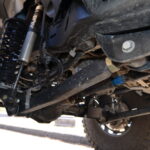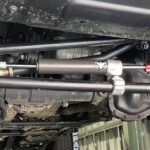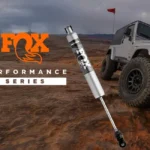
Death wobble – what causes it? Check your car’s suspension
You probably feel excited just thinking about driving an off-road vehicle, especially something like a Jeep. But sometimes, that nice vision can turn into a real nightmare. Have you heard of “death wobble”? If you have, you know what we’re talking about. Don’t let fear control you. Learn what causes this phenomenon, how to prevent it, and what to do if it happens. And don’t give up on your dreams of owning a Wrangler or Cherokee.
Which vehicles are prone to death wobble?
Although we started by mentioning Jeep, it’s not the only brand where the death wobble can appear. it’s not the only brand where this problem can appear. It also occurs in models like Suzuki, such as the Samurai and Jimny, or in any other off-road vehicle with a classic dependent suspension.
To be more specific, the tendency for death wobble mainly comes from the front design of this type of suspension. It includes a solid axle suspended by coil springs that separate the axle from the vehicle’s frame. Since there is only one point supporting the frame near the wheel, the front axle requires additional support.
Therefore, besides coil springs, there are also control arms that guide the axle, along with shock absorbers, and often a steering stabilizer and track bar (Panhard rod). This complicated setup works well off-road (due to increased wheel travel), but it’s less stable on the road compared to axles mounted on leaf springs. However, even with leaf springs, death wobble can occur if the suspension is not in perfect condition.
What is death wobble, and how dangerous is it?
So, what exactly is death wobble? It’s a sudden shaking of the steering system, which causes the steering wheel to move uncontrollably. In extreme cases, it can even be ripped out of the driver’s hands.
It starts when the vehicle hits a bump, and the force impacting the wheels transfers to the body, causing the entire vehicle to shake. The wheels begin to bounce like a boat riding the waves. You can imagine how much control you lose and how difficult it becomes to steer. Both turning and braking become almost impossible, especially if the driver panics.
What causes death wobble?
Death wobble usually happens during highway driving when you reach speeds over 70 km/h, but that’s not a strict rule. It starts when the vehicle hits a bump, and in vehicles where the front wheels work together (dependent suspension), the impact on one wheel affects the other. If all suspension parts are working properly, this shaking will be absorbed. However, if there’s any slack in the suspension, death wobble can occur.
Contrary to popular belief, death wobble doesn’t only happen in lifted vehicles with bigger tires. Lifted vehicles are more prone to it due to changes in the suspension angles (for example angle of steering knuckle ball joint). Moreover, when you frequently drive your vehicle off-road, you subject suspension components to intense stress. However, if you neglect the parts in a standard dependent suspension, you can similarly end up in trouble and experience vibrations.
How to fix death wobble? Checking for slack in the suspension
There are several possible direct causes of death wobble, but you should always start by checking the suspension and steering system. If you’ve modified your off-road vehicle, maybe the new parts were installed or adjusted incorrectly.
If your vehicle has been in use for a while, make sure no suspension part is worn out, bent, or damaged, and check for any slack at the connections. Often, replacing the faulty parts will fix the problem. After each repair, check the suspension’s geometry.
If everything looks fine at first glance, check if all bolts are tightened correctly with the proper torque. Start by checking the Panhard rod, ball joints, tie rods, upper and lower control arms, bushings, knuckles, and steering stabilizers.
Tests for diagnosing
Track bar test (sometimes referred to as a Panhard rod, Panhard bar or Track rod): the most important thing you can do at the beginning is to check if the bolts securing the rod to the frame are not worn out. There should be no slack. The next step is to check the rod’s bushings. For this, one person needs to get inside and turn the steering wheel a quarter turn while in neutral. Meanwhile, the other person should look underneath the car and observe the behavior of the rod. If it does not move as a whole but shows minimal movement at one of the bushings, that is a sign that it needs to be replaced. Similarly, check the other side of the mount; if the Panhard moves longitudinally at both bushings, then both need to be replaced.”
Control arms test: Check visually for bends, cracks, or looseness in the bushings
What else to check when your off-road vehicle shakes. Steering system
The steering stabilizers won’t directly cause death wobble, but it can hide the underlying problem, making it harder to diagnose. Sometimes, it’s a good idea to remove the steering stabilizer while checking for slack in other suspension components.
Also, take a look at the wheels and tires. While they usually aren’t the main cause, unbalanced wheels or worn tires can make the situation worse. It’s also worth checking the wheel geometry and ensuring that dirt or mud buildup on the wheels isn’t contributing to the shaking.
Related articles
Tests for diagnosing
Wheel bearing test: With the front of the car lifted, place your hands on the top and bottom of the tire. Pull the tire towards you and push it away. If the wheel moves, the bearings may be worn out.
Tie rod test: Similar to the wheel bearing test but place your hands on the sides of the tire and move it left and right. If you feel any mobement, it’s a sign that you need further inspection of the steering system. Co robić w czasie death wobble
What to do during death wobble?
First of all, after the initial shock, try to stay calm. Fear and stress aren’t good advisors, especially on the road.
Hold onto the steering wheel, but don’t grip it too tightly. Remember to protect your thumbs – don’t wrap them around the wheel. You could hurt your fingers if the steering wheel shakes violently.
Avoid sudden maneuvers or hard braking. Don’t rush to pull over, as you could end up in a ditch. Slowly reduce your speed until the shaking stops. In the case of death wobble, staying calm and reacting carefully is key.







Comments ()